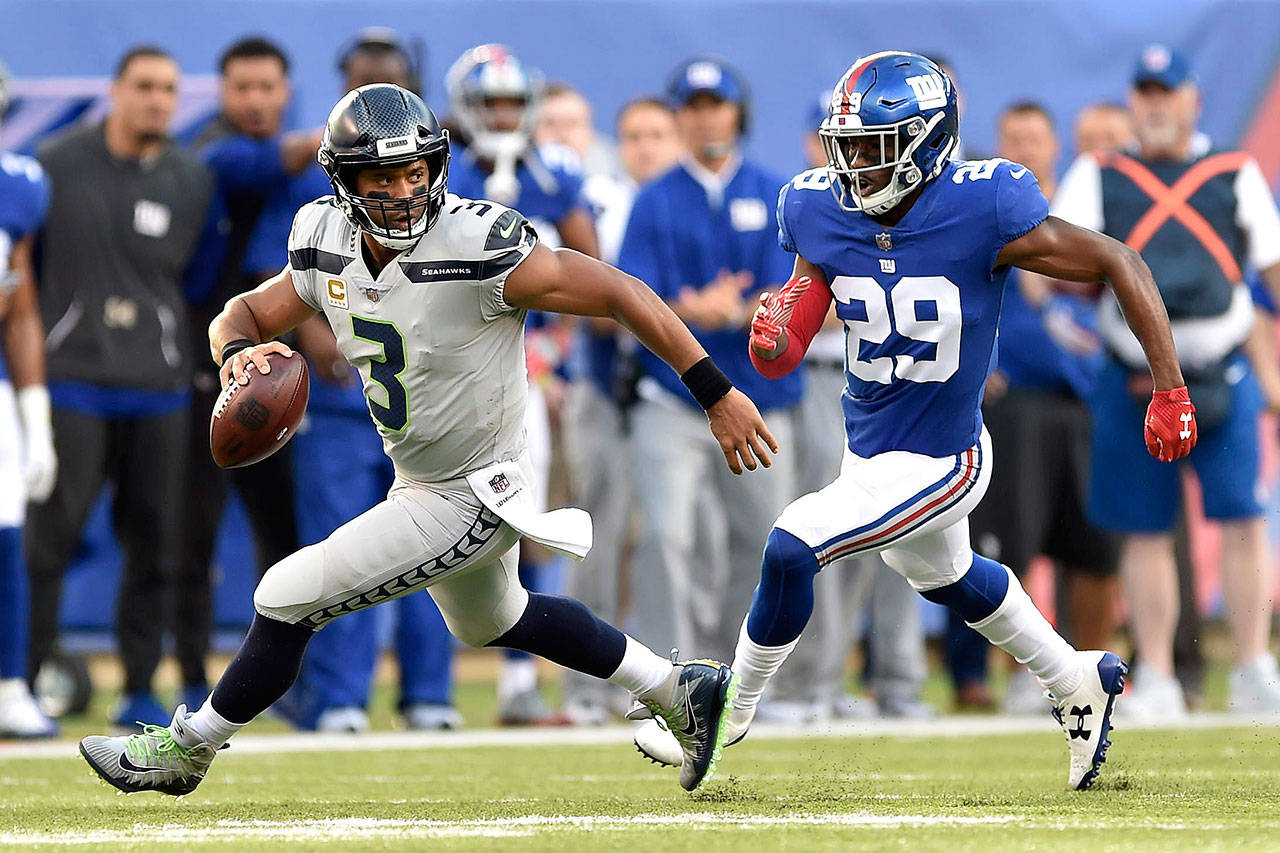EAST RUTHERFORD, N.J. — On a day when the Seattle defense proved anew, as Richard Sherman put it, that “We are who we think we are,” the Seahawks on offense finally showed a glimpse of being who they think they can be.
It only came, though, once they first gained control of their emotions, and then the ball on one controversial play in the fourth quarter that finally propelled Seattle to a harder-than-it-needed-to-be 24-7 victory Sunday over the Giants.
“It was a tough battle, man,” said Seattle receiver Paul Richardson.
He was talking about his 38-yard touchdown catch with 9:34 to play that came when he outfought New York’s Landon Collins for a throw from Russell Wilson. It came on the end of a double pass with the Seahawks clinging to a 10-7 lead, having just gotten the ball on a fumble by Giants quarterback Eli Manning.
But he could have been talking about how the offense spent most of the first three quarters, as coach Pete Carroll said, “kicking ourselves around.”
There were three dropped passes, one in the end zone by Jimmy Graham. There were two overthrows by Wilson, one on a potential touchdown in the third quarter. There were six penalties by the offense in the first half.
And in one of the more excruciating sequences in the team’s recent history, there were 10 plays run from the Giants’ 10-yard line or closer during a first-half drive that ended without a score (capped, fittingly, by Graham’s drop).
“We were moving the ball down the field, we just weren’t finding the end zone for whatever reason,” Wilson said. “Then we’d get a penalty and bring us back and then we’d do something silly.”
The frustration bubbled up later until receiver Doug Baldwin boiled over. One possession after the bizarre 16-play, 85-yard drive that somehow yielded nothing, Baldwin pushed offensive-line coach Tom Cable as Cable began talking to the offense.
Baldwin wanted Wilson to do the talking, apparently not knowing that Carroll had told Cable to start giving some instructions to the offense.
“I had told Tom to go and get in the middle of the offense,” Carroll said. “But Russ was ahead of us by a step. And he (Baldwin) tried to hold him (Cable) off because he wanted Russ to have his chance there.”
Said Baldwin: “I lost my cool. It’s 100 percent my fault.”
In fact, he said he later apologized to Cable, and the two could be seen chatting amicably as they walked off the field to the locker room at halftime, Cable with his arm around Baldwin.
Was the offense frustrated at that time?
“Of course it was,” Carroll said later with a laugh.
The good news was that while the offense was wasting its efforts, having gained 222 yards, the Seattle defense allowed the Giants just 42. New York’s touchdown came on a 17-yard drive following a Thomas Rawls fumble.
Before the first drive of the third quarter, Baldwin got the offense together again for a little talk, and the Seahawks responded with their first touchdown on a 22-yard pass from Wilson to Baldwin on a play when the Giants blitzed and left the middle of the field wide open.
“Cover zero, again,” Baldwin said of the fact the Seahawks have gotten many of their biggest pass plays in recent years in such situations. “Defenses, figure it out. They still haven’t figured it out.”
The game, though, still seemed too close for comfort as the Giants lined up for a second-and-five from their own 41 with just more than 10 minutes left, down 10-7.
But then Jarran Reed knocked the ball out of Manning’s hands with Frank Clark recovering at the 38.
On the next play, the Seahawks called for a double pass, Wilson pitching to J.D. McKissic who then threw backward to Wilson who then lofted it to a streaking Richardson who was tightly covered by Collins, New York’s Pro Bowl safety.
“I saw the ball, man I got excited,” Richardson said. “I jumped early and everything for it (and) he tried to snatch it away from me. Good catch, though.”
In fact, it was initially hard to tell who had it, with the Giants and their fans thinking it was an interception.
But referee Tony Corrente ruled that it was simultaneous possession, which means the ball goes to the offense, which meant a Seattle touchdown.
“We always catch those,” Carroll said, a wry reference to an even more controversial catch by Golden Tate that gave the Seahawks a victory over Green Bay in 2012.
Collins kept protesting in his postgame interviews, saying, “It was an interception. … I came down with the ball on my chest. Once I rolled over he was trying to fight back into possession for it. Once that happened he had no possession of the ball anymore. It’s crazy.”
Collins, in fact, came out of the pile holding the ball aloft. Richardson explained he let go once he heard the refs saying touchdown.
“He kept saying touchdown,” Richardson said. “That’s how I knew.”
Corrente said the post-catch “wrestling match” didn’t matter and that it was a touchdown when Richardson had at least equal possession of the ball when the play ended.
“That catch is established because if the defender was to pull the ball out of his hands now it’s still a catch,” he said.
That was all Seattle needed to finally grasp control of its third consecutive victory and improve to 4-2.
And finally the score also represented fairly the way Seattle dominated — the Seahawks had 425 yards to the Giants’ 177, the third time in four games the oft-maligned offense has gained at least 425 yards.
“We got better as the night went on,” Carroll said. “Maybe it was a little shabby out of the bye, I don’t know. It bodes well. We’re going to be all right. We’re going to be OK.”



